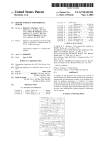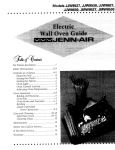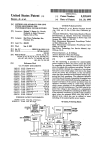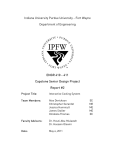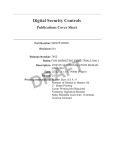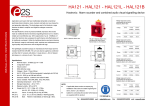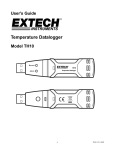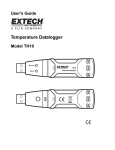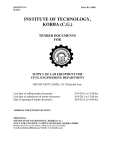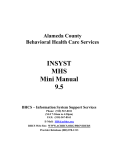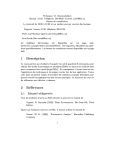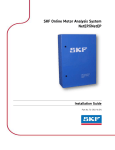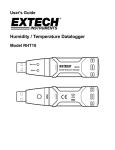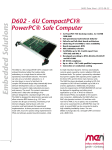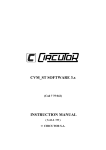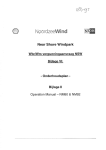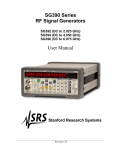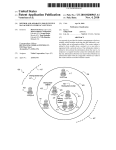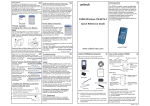Download Resume storage and retrieval system
Transcript
US006718345B2
(12)
(54)
United States Patent
(10) Patent N0.:
Hartman et al.
(45) Date of Patent:
RESUME STORAGE AND RETRIEVAL
SYSTEM
3/1998 Harple, Jr. et al. ....... .. 709/205
3/1998 Her-Hoyman et al. . 395/200.49
5,729,637 A
3/1998 Nicholson et al. ........ .. 382/282
2
,
’
(*)
Notice:
y
'
N
’
golf/T1 ettall- ----------- -
,
c
5,758,324 A
'
Apr. 6, 2004
5,724,508 A
5,727,156 A
(76) Inventors: Richard L. Hartman, 5205 N.
g/gillvzaflizaihhip?gif?glA
US 6,718,345 B2
5,781,785 A
0
e
a.
.
5/1998 Hartman et al. ............. .. 705/1
7/1998
Rowe et al.
.............. .. 707/513
Mulvaney Ct» Spokane’ WA(US)
5,832,497 A
11/1998 Taylor ....... ..
.. 707/1041
99212; ROY P- Massella, P-O- BOX
5,845,299 A
12/1998 Arora et al. .
...... .. 707/513
8435, Spokane, WA (US) 99203
5,892,905 A
Subject to any disclaimer, the term of this
4/1999 Brandt et al.
395/187.01
5,978,758 A
11/1999
Ono ............................ .. 705/1
5,999,939 A
12/1999 De Hilster et al. ....... .. 707/102
patent is extended or adjusted under 35
U.S.C. 154(b) by 0 days.
OTHER PUBLICATIONS
Nebel et al., “Request for Comments: 1876”, Xerox Corpo
(21) Appl- N91 10/437,650
(22) Filed:
May 13, 2003
ration (pp. 1—13 (Nov. 1995).
CallaWay, Erin, “High Tech Hunt”, Computerworla', p. 115
(65)
Scheier, Kevin, “Intellimatch Introducing NeWest Recruit
(Nov. 21, 1994).
Prlor Pubhcatlon Data
US 2OO3/O195767 A1 Oct 16 2003
7
ment Tool Since the PC”, Business Wire, Oct. 19, 1994.
“Using Restrac Sccanner With Restrac Hire and Restract
Related US, Application Data
(63)
Plan”, Restrac User Manual, Release 1.2, pp. 3—1 (1985).
“Using the Rescruiting Workbench”, Restrac User Manual,
Continuation of application No. 10/121,247, ?led on Apr.
Restrac Hire 3,1, pp, 5—2 & 6—3, (1996),
10, 2002, now Pat. No. 6,564,188, which is a continuation
of application No. 09/054,339, ?led on Apr. 2, 1998, which
-
is a continuation of application No. 08/597,359, ?led on Feb.
8’ 1996’ now Pat No_ 577587324'
-
Primary Exammer—charle.s Rones
(74) Attorney, Agent, or Fzrm—Wells St. John PS.
(60) ligg‘gisional application No. 60/008,700, ?led on Dec. 15,
(57)
( 51 )
Int. Cl. 7 .............................................. .. G06F 17/ 30
A
(52)
US. Cl. .................. .. 707/104.1; 707/102; 707/513;
resumé images in a manner Which Press/Wes the appearance,
(58)
Field of Search ........................ .. 707/104.1 103 R
709/205; 709/206; 705/1
(56)
’
’
met h 0 d 0 f an d a pp aratlls
f0r
'
l 0f
Stora g e an d retrleva
organization, and information content of the original docu
mm- In additiom Summaries or “Outlines” of resumé
707/102 513. 705/1. 709/2’05 206
’
ABSTRACT
images, broken doWn into multiple ?elds, are stored, and can
’
be searched ?eld by ?eld. Auser interface is provided Which
References Cited
is based on a familiar paper-based method already in com
mon use, thus reducing the training required to effectively
use the System_
5,164,897 A
11/1992 Clark et al. ............... .. 364/401
5,675,507 A
10/1997 Bobo, II ................... .. 709/206
PERSONAL INEORMAT/ON
11 Claims, 14 Drawing Sheets
ri37*\.
r’J/
NAME:
F/RST
M/DDLE
LAST
ADDRESS.‘
33%
cm
STATE/PROVINCE Z/P/POSTAL CODE
PHONE-[:II
-
~54~
OPT/ONAL mro/mr/o/v .» or 55 /- , 50
~34~
(A, 52
C/T/ZENSH/P: U 05 U CANADA \1 OTHERS/DEC/FY: @
SECURITY CLEARANCE B 557, .55
El PRESENT
3'’ 65
SUC/AL SECURITY
POSITION DES/RED
m5 ME:
,475
“ 74 \ lYPE/lj /7 PERM. U F7 TEMP. BE? PERM. [3 PT TEMP.
COMPENSAT/o/J. [El PU? Q WEEK Q MONTH U YEA/i’
DATE AVA/MELE. \Ekw 319784
C/TY,
9B '4.’
MAJOR DEGREE WEI NAME STATE/PROVINCE GPA (
H/GH SCHOOL:
.77
/
*
WMGE-EEHEHEHIEJE;
EMPLOYMENT HISTORY (REPEAT AS NEEDED)
START DATE’ \EI
708 /’
END DATE: El
SUPERV/SOR NAME:
1M1’ 122
745 E 7
VOCAEULARY
ASS/STANCE
124 r 97%
U.S. Patent
Apr. 6, 2004
20—\ RAM
Sheet 2 0f 14
US 6,718,345 B2
ROM r22
LONG TERM
MEMORY x
A
1
C OMMUN/CA T/ON r 24
HARDWARE
.21 E257
U.S. Patent
Apr. 6, 2004
Sheet 3 0f 14
US 6,718,345 B2
PERSONAL /NEORMAT/ON r311
NAME-l
~J9~
ADDRESS:|
|
~ 32 ~
||
r37
~41~
E/RST
M/DDLE
~45~
~44~
~48~
ll
O/TY
~42~
|
LAST
||
|
I
~50~
STA TE/PRO V/NCE ZIP/POSTAL OOOE
PHONE-CE
EMA/L.-[
||
FAY-l
~54~
~56~
OPT/ONAL /NEORMA MON
|
l-Ak 37
58
50
62
~54~ O/T/ZENSH/P- 6M5 @NADA ?OTHERSPEO/EY E
SECURITY CLEARANCE‘
PAST 55
[gift-SENT
SOc/AL SEOuR/TY ,741; @5765
POS/T/ON OES/REO
JOB T/TLE- |
r37
~ 72~
75
l
75
50
“'36~ 74 w FT PERM. U /-T TEMP. DTD?ERM. [52 TEMP.
OOMPENSA T/ON.-
PER
WEEK
DA TE AVAILABLE: @ 37
84
86
EDUCATION
~38~
H/GH SCHOOL:
MONTH Ql/EAR
88
cm,’
98
MAJOR OEOREE LNST. NAME STA TE/PROv/NcE 673%
37x4
~94~
||
~96~
1|
OOLLEOE~|~1OO~||~7O2~|| ~704~ ll
~706~
||
EMPLOYMENT H/STORY (REPEAT AS NEEOEO)
EMPLOYER NAME.-|
EMPLOYER O/TY, STATE-|
~40~
JOB T/TLE-l
START DATE: @
SUPERVISOR NAME'I
7
708
~770~
|
~117~
|| ~772~|
~114~
|
END DATE: E
~120~
|
W122
124%
746 R MOOABOLARY
ASS/STANOE
ml 3
\/5O
U.S. Patent
Apr. 6, 2004
PERSONAL INFORMA T/ON
T
Sheet 4 0f 14
US 6,718,345 B2
f’ 3 7 a‘
~46~
||
CITY
r .3 7
~48~
||
~50~
|
57A TE/PRO VINCE Z/P/P05 TAL CODE
OPT/O/vAL lNEORMA T/ON
58
50
52
CITIZENSHIP: [5M5 IjELA/ADA ?OTHERsPEO/EY; @
SECUR/TY CLEG‘EANCE'
PAST 56 68
POSITION TO BE E/LLED
JOB T/TLE-l
~72~
PRESENT
F57
l 78
76
50
74 {?g/Cl ET PERM. U ET TEMP. UPT/PERM. 62 TEMP.
COMPENSATION:
PER
WEEK
DA TE NEEDED: [Ilq 3 7
EDUCATION
54
MONTH
55
YEAR
55
CW
MW.
MAJOR DEOREE INST. MAME STA TE/PROv/MOE GPA
H/GH SCHOOL:
|
~94~
IT ~96~ 98)]1
OOLLEOE- |~TOO~|I~TO2~|| ~704~ ||
EMPLOYMENT H/sTORY
EMPLOYER NAME-I
EMPLOYER O/TY, STATE:|
JOB T/TLE-l
F31
~706~
l
JI
7
708
~1 70~
|
~777~
~774~
ll ~112~J
|
MIN. MO. ExPER/E/vcE- |:]<~57 “A
$uPERv/sOR MAME-l
~720~
W742
748 _\ YOOADMLARY
ASS/STANCE
I
144%
U.S. Patent
Apr. 6, 2004
Sheet 5 0f 14
US 6,718,345 B2
CITY, ST.‘ WASHINGTON, DC
SECURITY.‘ CURRENT
DES/RED: MATERIALS SPECIAL/ST
TYPE: FULL TIME PERMANENT
COMP: ~$6000 PER MONTH
AVAILABLE: JULY 7996
COLLEGE‘ MASS. INSTITUTE OF TECH.
COLLEGE GPA.’ 3.5
EMPLOYER.’ DEPARTMENT OF DEFENSE
JOB TITLE.‘ MATERIALS RAD/OLOG/ST
F
57 5
,
CELLULAR,
JOB m5
SATELLITE
‘
VOCABULARY
ASSISTANCE FOR
"JOB TITLE "
DEVEL OPMEN T
FIRMWARE
SOFTWA RE
SYSTEMS
I
72w
CELLULAR,
JOB TITLE:
SA TELL/ TE,
FIRMWARE
.ZLHE
J
U.S. Patent
Apr. 6, 2004
JOHN DOE
7234 ANY STREET
SMALLTOWN CA 92047
Sheet 6 0f 14
US 6,718,345 B2
679—~555—727Z (VOICE)
-_
679—555—7277 (FAX
[email protected] (EMAIL)
CAREER
SUMMARY
75 YEARS OF /N—DEPTH INDUSTRY EXPERIENCE
FIRMWARE DESIGN.‘ INTEL (8048, 8057, 80960, 8OX86);
MOTOROLA (68OX); ASSEMBLY AND C/C++;
NETWARE, IBM PC.
SYSTEM DESIGN: SOI-TWARE/HARDWARE ARCHITECTURE;
COMMAND SET DESIGN; LOCAL AREA NETWORKS,’
ERGONOMICS; SPACE-QUALIFIED SYSTEMS (MIL-58570
SPACE FLIGHT DESIGN RULES).
CIRCUIT DESIGN.‘ DIGITAL, AUDIO, AND VIDEO CIRCU/TRY;
LOW NOISE; LOW DISTORT/ON; CROSSTALK SENSITIVE.
OCCUPA TIONAL
EXPERIENCE
CELLULAR SATELLITE CORPORATION
SAN DIEGO CA
MAR 88- MANAGER OF SATELLITE SOITWARE DEVELOPMENT.‘
PRESENT MANAGE DEPARTMENT, RESPONSIBLE FOR ALL
EARTH-TO ORB/T L/NKUP FIRMWARE, HOST
INTERFACE, PROTOCOLS, ETC.
JUL 87
SUPERVISOR OF CELLULAR FIRMWARE ENGINEERING:
SUPERVISED FIRMWARE DESIGN INCLUDING OS
ARCHITECTURE, CELL ROUTING, AND DROPPED LINK
HANDLING DATA COMPRESSION AND ENCRYPT/ON.
U.S. Patent
Apr. 6, 2004
Sheet 7 0f 14
US 6,718,345 B2
S7
HAS A
CLIENT CONNECTED
TO THE SYSTEM?
YES
) 7'0
( FIG 8B
58
/s /r
TIME TO UPDATE
EXISTING APPLICANT
INEORMA TION?
YES
NOT/FY ASSOCIATED
APPLICANT(S) THAT UPDATE
IS RECOMMENDED
S9
IS IT TIME
TO AUTOMATICALLY
K S70
PERFORM
SUSPENDED SEARCHES
CONTINUE SUSPENDED
SB4RCHES?
HAS
SYSTEM OPERA TOR
REOUES TED
SHUTDOWN?
S77
U.S. Patent
Apr. 6, 2004
FROM )
FIG 8A(
Sheet 8 0f 14
SEND MAIN MENU,
“
US 6,718,345 B2
r52
7 REQUEST SELECTION
2.1g EB
DID USER
SELECT "ENTER NEW
APPLICANT DATA"?
N0
YES 9
53
DID
USER SELECT
"UPDA TE EXIS T/NC
APPLICANT
YES a
DA TA "?
S4
N0
DID USER
SELECT "BEGIN
NEW SEARCH OF
YES 3
APPLICANTS"?
N0
55
DID
USER SELECT
"CONTINUE SUSPENDED
SEARCH OF
YES 0
APPLICANTS"?
S6
S65
NO
/
S64
T/MED
Our?
NO
YES
TERM/NA TE _,@>
CONNECT/0N
U.S. Patent
Apr. 6, 2004
Sheet 10 0f 14
US 6,718,345 B2
K S25
SEND TO CL/ENT A MESSAGE
REQUEST/NO APPLICANT
/D AND PASSWORD
1
RECE/VE AND
5251 VER/FY RESPONSE
‘
K527
RETR/EVE EX/ST/NG RESUME
OUTL/NE EROM DATABASE
V
E/LL EMPTY RESUME
OUTL/NE FORM W/TH
RETR/EVED EORM'S CONTENTS
/
S28
U.S. Patent
Apr. 6, 2004
Sheet 11 0f 14
US 6,718,345 B2
K 529
SEND TO CLIENT A MESSAGE
REQUEST/NC CLIENT
ID AND PASSWORD
RECEIVE AND
550/ VERIFY RESPONSE
SEND TO CLIENT A LIST
OF THIS CL/ENT’S SUSPENDED
SEARCHES AND REOUEST SELECT/ON
‘
S32—*\ RECEIVE SELECT/ON
V
FILL EMPTY RESUME
OUTLINE EORM WITH
SELECTED SEARCH CRITERIA
I
S33
S37
U.S. Patent
Apr. 6, 2004
Sheet 12 0f 14
US 6,718,345 B2
Q) f 534
PREPARE EMPTY
RESUME OUTLINE FORM
V
SEND OUTLINE FORM TO CLIENT,
AND REQUEST RETURN W/TH
/ 555
DES/RED SEARCH CR/TER/A
Jr
RECEIVE RESPONSE \ 535
S45
D/D
CL/ENT REQUEST
ADD REQUESTED
VOOABULARY
ASS/STANCE?
VOCABULARY
ASS/STANCE TO
RESUME OUTL/NE FORM
D/D
YES
CL/ENT REQUEST
SEND r0 CL/ENT A
REQUEST FOR A CLIENT
/D AND PASSWORD
SUSPENSION OF THIS
SEARCH?
@
558
N0
547
RECEIVE AND
_’ VERIFY RESPONSE
Jr
545x STORE SEARCH CR/TER/A
Av
Av
FROM
7 25
TO
72B
@
FHJEW
—
U.S. Patent
Apr. 6, 2004
Sheet 13 0f 14
TO 72A
EROM 72A
AV
T
US 6,718,345 B2
K 559
SEARCH DATABASE OF EXISTING RESUME OUTLINES
v‘
A‘
SUMMARIZE COMPLIANT RESUME OUTLINES, SEND
TO CLIENT, AND REQUEST DES/RED ACT/ON
*
\
54 7 J RECEIVE RESPONSE
540
DID
CLIENT CHOOSE
TO MODIFY SEARCH
CRITERIA?
YES
S42
DID
CLIENT CHOOSE
TO VIEW AN ENTIRE
OUTLINE?
544
NO
543
SEND TO CLIENT A LIST OF AVAILABLE RESUME
OUTLINE DEL/VERY METHODS, AND REQUEST SELECTION
i
RECEIVE RESPONSE #549
+
SEND COMPLETE RESUME OUTLINE TO
K CLIENT AND REQUEST DESIRED ACT/ON
S50
D/D
CLIENT CHOOSE
TO PURCHASE ASSOCIATED
RESUME
IMAGE?
S57
£1 E JEE
@
U.S. Patent
Apr. 6, 2004
Sheet 14 0f 14
SEND TO CLIENT A MESSAGE
ASKING IF CLIENT HAS AN
EXISTING ACCOUNT ON SYSTEM
US 6,718,345 B2
S52
I
RECEIVE RESPONSE
S53 J
S67
S54
DID
CLIENT RESPOND
AFF/RMA TIVEL Y?
S55
SEND TO CL/ENTA REQUEST
FOR CREDIT CARD OF OTHER
BILLING INFORMATION
1
x
RECEIVE RESPONSE
SEND TO CLIENT A REQUEST FOR
ACCOUNT ID AND PASSWORD
S56
K’
\ S62
DOES
‘L
BANK OR OTHER
FINANCIAL INSTITUTION
RECEIVE AND
VERIFY RESPONSE
CONFIRM CL/ENT'S BILLING
INFORMATION?
v
SEND TO CLIENT A LIST
OF AVAILABLE RESUME IMAGE
DEL/VERY METHODS AND
REOUEST SELECTION
+
_\ S57
RECEIVE RESPONSE & 558
+
RETRIEVE RESUME IMAGE
FROM DATABASE
I
DELIVER RESUME IMAGE TO
CLIENT V/A SELECTED METHOD \
f
S60
US 6,718,345 B2
1
2
RESUME STORAGE AND RETRIEVAL
SYSTEM
methods on the resulting text of full resumés, in an attempt
to ?nd those Which contain key Words or phrases. HoWever,
such methods have proven inef?cient because of the nature
CROSS-REFERENCE TO RELATED
APPLICATION
of Written language. As just one example, an employer
seeking applicants residing in the state of Indiana Will ?nd
numerous false matches When searching With the standard
This is a continuation of US. patent application Ser. No.
postal service abbreviation “IN”. The letter pair “in” appears
10/121,247, ?led Apr. 10, 2002, now US. Pat. No. 6,564,
188 Which in turn is a continuation of US. patent application
Ser. No. 09/054,339, Which Was ?led on Apr. 2, 1998, Which
a continuation of US. patent application Ser. No. 08/597,
359, ?led Feb. 8, 1996, now US. Pat. No. 5,758,324, Which
in turn claims priority from US. Provisional Application
Ser. No. 60/008,700, ?led Dec. 15, 1995, all of Which are
incorporated by reference herein.
frequently in the English language (many times in this
10
true intent.
A further dif?culty With “keyWord” search methods is the
requirement that the Words or phrases in question must
match With near-perfect accuracy. The diversity of job
15
similar attributes, to be Written using very different terms
and phrases. Such Wide variation causes “keyWord” search
The invention relates to electronic resumé storage and
retrieval systems and methods.
methods to often erroneously exclude quali?ed applicants—
20
BACKGROUND OF THE INVENTION
employers and job applicants (candidates). Employers annu
ally spend billions of dollars to solicit resumés using neWs
usefulness. For example, many have been intended for use
25
seminars, and other methods. In response, job applicants
spend billions more to compose, typeset, print, and ship
only by employers, employment specialists, or “headhunt
ers.” Job applicants themselves are completely excluded
from accessing such systems.
those resumés.
expensive and frustrating for job applicants. Identifying
Without noti?cation to ii the searcher—While simultaneously
including unquali?ed ones.
Prior attempts at applying computer technology to resume
management have been limited in scope, applicability, and
Resumes are a primary communication medium betWeen
Unfortunately, present resumé delivery practices are
applicant Writing skills and vocabularies causes many
resumés, Which otherWise might describe applicants With
TECHNICAL FIELD
paper advertisements, job fairs, college recruitment
sentence alone), yet most such matches in the full text of a
resumé Would have little or nothing to do With the searcher’s
One prior attempt, described in US. Pat. No. 5,164,897 to
30
Clark et al. (incorporated by reference), is illustrative. The
?rst sentence of the prior art section of this patent describes
potential employers, obtaining addresses, producing
the prior art as applying to “employment agencies
resumés for each, and ?nally delivering them is burdensome
(sometimes called search ?rms).” The preferred embodi
and time-consuming. The success rate for such efforts is
discouragingly loW, and the associated expenses can be quite
signi?cant. This makes the entire process quite inef?cient
from the applicant’s point of vieW.
Employers, too, suffer from the inefficiencies of resumé
ment section of the patent then describes a system designed
for use by such agencies and ?rms—Without direct applicant
involvement of any kind.
Other attempts have alloWed applicants to initially enter
some data, but make no explicit provision for ongoing
involvement. Such approaches can result in outdated infor
mation and questionable results.
collection and handling. The solicitation, receipt, storage,
management, search, and retrieval of doZens, hundreds, and
in some cases thousands of resumés can be a dif?cult,
35
40
Other attempts have required the installation of special
iZed computer hardWare and/or softWare, or personnel train
ing at the employer’s place of business. The dif?culty in
unWieldy, and expensive burden on the employer. Physical,
paper-based resumés are often stored in desk draWers and
?ling cabinets. The numerous limitations of present resumé
practices include consumption of substantial physical space;
dif?culty in searching through large quantities of paper
documents; the near-impossibility of correlating applicants
learning and using the system often effectively restricts
45
Other attempts have incorporated rudimentary computer
based searching methods. The most common method
involves the aforementioned “keyWord” searches on the
contents of entire resumés, such as offered by Online Career
Whose resumés may vary Widely in organiZation, content,
and clarity; and the lack of uniformity in the search process
from one practitioner to another.
access to just those Who have been appropriately “trained.”
50
From the above discussion, it is clear that a very signi?
cant need exists for an improved method of resume
Center, Indianapolis, Ind. and TMP Interactive,
Framingham, Mass. The inherent limitations of such meth
ods have already been discussed.
solicitation, sorting, delivery, handling, and management.
Another attempt at incorporating computer-based search
Yet prior attempts to resolve some of these problems have
ing methods is seen in the services available from
achieved only limited success. Document scanners have 55
Intellimatch, San Jose, Calif., (Internet address: http://
WWW.intellimatch.com). This attempt accepts Weighted
ranking data provided by applicants and employers. There
been used in some attempts to reduce the physical space
consumed by physical resumés. HoWever, search methods
do not Work Well on scanned images because scanned
are several disadvantages of this type of method: First, the
user interface for interacting With such ranking systems can
resumés are stored as pictures, not searchable Words or text.
Optical Character Recognition (OCR) has been used in
60
some attempts to convert paper-based resumés to pure text.
sloW to operate. Second, there is no objective reference for
ranking standards—individual applicants are asked to rank
HoWever, employers are typically unWilling to forgo the
traditional resumé because of the Widely held belief that the
themselves, leading to an extremely subjective collection of
personal opinions. Third, employers are asked to rank their
ability to revieW the format, style, and presentation of the
resume itself is of value.
Still other attempts have employed the aforementioned
OCR conversion to alloW the use of “keyword” search
be complex, non-intuitive, unfamiliar, dif?cult to learn, and
65
requirements in a like fashion, again Without reference to an
objective standard. Fourth, these highly subjective data are
then compared to each other, compounding assumptions
US 6,718,345 B2
4
3
upon assumptions and often yielding startlingly mismatched
One embodiment of the invention employs common and
and valueless results.
Another attempt at providing resumé services on the
Internet is provided by Beverly Hills Software, 469 South
commercially available computer hardWare and softWare to
reduce or eliminate the need for specialiZed equipment by
and training of the applicant or employer.
Bedford Drive, Beverly Hills, Calif. 90212, (Internet
address: http://WWW.Bhs.Com). This attempt prompts appli
munications systems for billing and payment for services.
One embodiment of the invention employs modern com
cants to enter text-only information using a template.
Other features of the invention Will become apparent to
those of ordinary skill in the art upon revieW of the folloWing
HoWever, keyWord searches still involve searching the entire
contents of resumé data; no searching by ?elds is available.
A visual template is provided for applicant data, but the
10
detailed description, claims, and draWings.
resulting pure text is sorted as one large text ?le, like other
BRIEF DESCRIPTION OF THE DRAWINGS
systems. There is also no provision for charging or collecting
fees.
Some of the aforementioned examples have attempted to
beloW With reference to the folloWing accompanying draW
Preferred embodiments of the invention are described
incorporate various remote connection means. Such remote 15
ings.
methods have traditionally been limited to text-only resume
storage and keyWord-based searches of the full resume text.
None have succeeded in addressing all of the problems
FIG. 1 is a block diagram illustrating a system embodying
the invention.
described above.
system shoWn in FIG. 1.
FIG. 2 is a block diagram of a server included in the
FIG. 3 is an example of a resume outline form sent from
the server of FIG. 2 to an applicant’s client machine
SUMMARY OF THE INVENTION
The invention provides a method of and apparatus for
storage and retrieval of resumé images in a manner Which
preserves the appearance, organiZation, and information
content of the original document.
One embodiment of the invention provides a method of
and apparatus for storing formatted summaries or “outlines”
included in the system of FIG. 1.
25
included in the system of FIG. 1.
FIG. 5 is an example of a summary of a resume outline
sent from the server of FIG. 2 to an employer’s client
machine in response to a search request.
of resume images, and ef?cient searching and subsequent
selection of the resume outlines and their associated resume
FIG. 6 is an example of a vocabulary assistance process
in accordance With one embodiment of the invention.
images.
One embodiment of the invention provides a user inter
FIG. 7 is an example of a resume image stored by the
face for creating the aforementioned resume outlines Which
server of FIG. 2.
is based on a familiar paper-based method already in com
mon use, thus reducing the training required to effectively
use the system.
FIG. 4 is an example of a search request form sent from
the server of FIG. 2 to an employer’s client machine
35
One embodiment of the invention provides a method of
FIGS. 8A, 8B, 9—11, 12A, 12B, and 13 de?ne a ?oWchart
of a process performed by the server of FIG. 2. in accor
dance With one embodiment of the invention.
and apparatus for computer-assisted searching of the afore
DETAILED DESCRIPTION OF THE
PREFERRED EMBODIMENTS
mentioned stored resume outlines in a manner Which mini
miZes the need for specialiZed equipment and training. In
one embodiment, such searches can be suspended, and
This disclosure of the invention is submitted in further
resumed at a later time.
ance of the constitutional purposes of the US. Patent LaWs
One embodiment of the invention provides a method of
and apparatus for enabling the automatic and continuous
execution of the searches through resume outlines, thereby
determining When a potentially qualifying applicant has
“to promote the progress of science and useful arts” (Article
1, Section 8).
45
entered their resume outline and resume image and enabling
employers to be automatically noti?ed thereof.
memory 14. The server 12 can be a minicomputer, a
One embodiment of the invention provides a method of
microcomputer, a UNIX (TM) machine, a mainframe
and apparatus for coordinating the terminology and vocabu
computer, a personal computer such as an Intel
lary used by applicants and potential employers in the entry
PC,
286, 386, 486, Pentium, P6, etc. (TM) personal computer or
and searching of the aforementioned resume outlines.
personal
clone, or computer
Apple (TM),
or clone,
Macintosh
or any(TM),
otherorappropriate
PoWerPC com
One embodiment of the invention provides a method of
and apparatus for the controlled expansion of the terminol
ogy and vocabulary used by applicants and potential
FIG. 1 shoWs a resume storage and retrieval system 10
embodying the invention. The system 10 comprises a server
12 including a memory 14, and a database 16 de?ned in the
55
employers in the entry of and searching of the aforemen
puter. The memory 14 is preferably long term memory (e.g.
hard drive, disk drive, tape unit, CD-ROM, etc.). The server
12 includes typical components (FIG. 2) such as a CPU or
tioned resume outlines.
One embodiment of the invention employs modern com
munications systems, such as the Internet, the “World Wide
processor 18, input devices such as a keyboard (not shoWn),
and mouse (not shoWn), output devices (not shoWn) such as
a monitor and printer, RAM 20, ROM 22, serial ports (not
Web”, or other commercial “connectivity services”, for
shoWn), parallel ports (not shoWn), and communication
applicant submission of outlines or resume images, or
hardWare 24, Which may either be internal or external, such
employer searches through outlines or vieWing of resume
as internal communication cards (e.g., modem card or net
images.
Work card) or external communication hardWare (e.g., exter
nal modem), etc. In one embodiment, the communication
One embodiment of the invention employs modern com
munications systems to automatically notify applicants or
employers under certain conditions, such as the expiration of
a time interval or occurrence of an event.
65
hardWare 24 connects the server 12 to the Internet, so that
the server 12 de?nes an Internet node. More particularly, in
one embodiment, the server 12 is a World Wide Web server
US 6,718,345 B2
5
6
connected to the Internet. In this embodiment, the server 12
110, 111, 112, 114, 116, 118, and 120 for employer name,
employer city, employer state or province, previous job title,
has a multi-user, multi-tasking operating system such as
UNIX (if the server is a UNIX machine), Windows NT,
LINUX (if the server is a personal computer), etc.
The system 10 further includes a job applicant’s client
start date for that position, and end date for that position
(multiple copies of ?elds 110, 111, 112, 114, 116, 118, and
120 can be included for multiple prior positions).
machine (or applicant’s client machine) 26 in selective
Other or additional ?elds can be used, as desired, or
synonyms can be used in place of the Words shoWn in FIG.
communication With the server 12.
The job applicant’s client machine 26 is connected to the
3 adjacent the ?elds. For World Wide Web applications, the
server 12 via a communication link 28. Various possible
form 30 is an HTML form, and has “submit” and “clear”
buttons 122 and 124 using Which the applicant can either
types of communication link can be employed for the
send the information from the ?lled ?elds to the server, or
can clear the form and start over. The form 30 further
communication link 28 betWeen the server 12 and the
applicant’s client machine 26. For example, the communi
includes a “vocabulary assistance” button 146, the function
of Which is discussed beloW.
cation link 28 can comprise a hard Wired connection, a
telephone connection, a satellite RF, or other Wireless
connection, an Internet connection, a local area netWork or
15
Upon receiving the form 30, the job applicant ?lls in
Wide area netWork connection, a combination of the
(using his/her machine 26) as many ?elds 31 as desired,
preceding, or any other desired type of connection. Many
applicant’s client machines 26 can communicate With the
including some mandatory information such as name and
server 12 at the same time. Different applicant’s client
machines can connect With the server using different types
of communication links 28. For example, one of the com
munication links 28 can be a hard Wired connection While
another one of the communication links 28 is a telephone
tion 32. The applicant also effects creation of a graphics ?le
connection.
After the communication link is established, communi
cations can take place over the link using any of various
contact information (address and/or phone number) in sec
126 (FIG. 7) of the applicant’s resume for receipt by the
server.
The graphics ?le 126 contains all the formatting, fonts,
25
folloWing extensions: .GIF, .TIF (or .TIFF), .JPG (or .JPEG
protocols, such as e-mail, FTP (?le transfer protocol), TCP/
IP (Internet protocol, Which can be used With HTTP-hyper
text transfer protocol, or GOPHER), ASCII, X-MODEM,
or .JPE), .BMP, .TGA, .EPS, .PCX or another form of
graphics ?le that maintains the appearance, format
information, and font information of the original document.
The applicant can create the graphics ?le in any appropriate
Y-MODEM, KERMIT, any variations on these protocols, or
any other appropriate protocol.
manner at a location 134 remote from the server 12.
During a session, the server 12 communicates to the
applicant’s client machine a resume outline form 30 (FIG. 3)
to be completed by a job applicant. The form 30 has a
plurality of ?elds 31 relevant to employment, using Which
and margins of a traditional paper resumé, and is of great
assistance to employers Wishing to gain some insight into
the professionalism of an applicant. The graphics ?le can be,
for example, in a ?le format identi?ed by one of the
35
For example, the applicant can create the graphics ?le
using a scanner 128 (FIG. 1), by scanning his or her actual
printed resumé. Alternatively, the applicant can use a fac
simile machine 130 (FIG. 1) to fax his or her actual printed
typical information found on a resume is summariZed by the
applicant. The form 30 has ?elds that are similar to blanks
found on traditional job application forms available from
resume to a facsimile machine 132 in the possession of the
administrator of the system 10 (e.g., located at the location
of the server 12). The facsimile machine 132 creates graph
ics ?le 126 that is stored by the server. In one embodiment,
the system administrator can convert the graphics ?le from
employers.
In the illustrated embodiment, the form 30 has various
sections, such as a personal information section 32, an
a fax format to one of the above mentioned graphics ?le
optional information section 34, a position desired section
36, an education section 38, and an employment history
names, address, city, state or province (e.g., the tWo letter
formats. Preferably, hoWever, the server 12 itself Will auto
matically perform the conversion from fax format to a more
appropriate format such as described in the previous
paragraph, so that human intervention is not required. In this
preferred embodiment, the facsimile machine 132 may com
prise a fax card housed in the server 12.
In another embodiment, the system administrator can
postal service abbreviations), Zip code or postal code, phone
number, fax number, and e-mail address, respectively; the
receive a mail copy of a printed resumé, and can scan it into
the server 12 for the applicant using a scanner 133 in the
section 40. Other sections can be used, as desired. Each
section has various ?elds 31.
45
For example, in the illustrated embodiment, the personal
information section 32 has ?elds 39, 41, 42, 44, 46, 48, 50,
52, 54, and 56 for the job applicant’s ?rst, middle, and last
optional information section 34 has ?elds 58, 60, 62 and 64
relating to citiZenship, ?elds 66 and 68 relating to security
possession of the system administrator (e.g., located at the
clearance, and a ?eld 70 for a social security or social 55
The server 12 receives and stores in the database 16 the
graphics ?le 126 as Well as an entry de?ned by the summary
location of the server 12).
insurance number; the position desired section 36 has a ?eld
72 for job title, ?elds 74, 76, 78, and 80 relating to the type
of employment sought (full time permanent, full time
temporary, part time permanent, or part time temporary),
?elds 82, 84, 86, and 88 relating to compensation
information ?lled in on the form 30 by the job applicant.
requirements, and a ?eld 90 relating to the date When the
applicant Will be available for the neW position; the educa
summary information can be sent from the applicant’s client
machine 26 to the server 12 via HTML, and the graphics ?le
126 can be sent from that applicant’s client machine 26 to
tion section 38 has ?elds 94, 96, 98, 100, 102, 104, 106, and
108 relating to majors, degrees, school names and locations,
and grade point averages (multiple copies of ?elds 100, 102,
104, 106 and 108 can be included for multiple colleges
attended); and the employment history section 40 has ?elds
In one embodiment, the graphics ?le 126 can be commu
nicated to the server using a different protocol than Was used
for transmitting the summary information. For example, the
65
the server 12 via e-mail. Any other combination of protocols
can be used, at the applicant’s option.
The form 30 is useful in that it provides searchable
information. The information of the graphics ?le 126 cannot
US 6,718,345 B2
7
8
be easily searched. In addition, the form de?nes ?elds 31, so
form in a HTML application). This results in the employer’s
that searches can be performed by ?eld, by prospective
client machine 138 providing a search request to the server
12 and initiating a search of the summary information in the
database 16. As Was the case With the applicant’s form 30,
the form 136 also includes a clear button 144, in an HTML
employers. Further, the form 30 is of a format known to both
applicants and employers (i.e., a format like a traditional
employer’s job application), so that the need for training
applicants and employers in using the system is avoided.
Instead, applicants can easily ?ll the form 30, and employers
application, using Which the employer can clear the form
136 and start over.
can easily search the database. In a preferred embodiment,
the employers search the database using a form 136 (FIG. 4)
that is very similar in appearance to the form 30 presented
to applicants. The forms 30 and 136 provide a standard
10
The server 12 associates or links the summary informa
15
resume at some later time. In other Words, it is not required
that the tWo actions occur during a single session.
citiZens AND be engineers OR scientists. Alternative appro
20
priate systems for creating search queries can also be
employed. For example, different ?elds 31 can be assigned
25
different importance Weights. It may be more critical to have
a close match in the city ?eld in the Personal Information
section than to have a close match in the compensation ?eld.
In one embodiment, employers are able to indicate logical
connectors betWeen keyWords, such as “engineer NOT
The system further comprises an employer’s client
machine 138 in selective communication With the server 12.
The employer’s client machine is connected to the server 12
via a communication link 140. Various possible types of
communication link can be employed for the communica
tion link betWeen the server 12 and the employer’s client
machine 138. For example, the communication link 140 can
comprise a hard Wired connection, a telephone connection,
30
to the employer’s client machine an amount of the summary
35
(search query). Preferably, contact information (e.g., name,
address, phone number, e-mail, fax number, etc.) of quali
40
fying applicants is suppressed at this stage. In one
embodiment, the information presented to the employer for
each entry that satis?es the search parameters is “summa
riZed” information, for easy and quick revieW in a
standardiZed, compact, format. An example of summariZed
a satellite RF, or other Wireless connection, an Internet
can communicate With the server 12 at the same time that
one or more applicant’s client machines 26 are connected to
the server 12.
Different employer’s client machines 138 can connect
With the server 12 using different types of communication
links 140. For example, one employer’s client machine 138
can be communicating With the server 12 using a telephone
information is shoWn in FIG. 5.
Relevancy ranking is performed in a preferred embodi
ment. The relevancy ranking identi?es entries in the data
45
50
performed by: CPL Retrieval Engine, sold by Personal
Library Systems, 2400 Research Blvd., Suite 350,
Rockville, Md. 20850; NexTrieve Indexing Engine from
55
Nexial Systems, St. Annastraat 4, 6109 RH, Ohéen Laak,
The Netherlands; MetaMorph Text Retrieval Engine sold by
Thunderstone SoftWare—EPI Inc., 11115 EdgeWater Drive,
Cleveland, Ohio 44102; InTEXT Retrieval Engine, sold by
InTEXT Systems, 715 Sutter Street, Folsom, Calif. 95630;
communicates With the server 12 using an Internet connec
the preferred embodiment. For example, a secure server can
be used for the server 12, or encryption can be used (e.g.,
using PGP—pretty good privacy encryption, such as is
provided by ViaCrypt (TM) softWare, or some other encryp
tion method).
Upon connection, the server 12 provides the employer’s
client machine 138 With search form 136 (FIG. 4). The
search form 136 is preferably similar to the form 30 ?lled by
applicants, as described above, and preferably includes
or Fast Data Finder, sold by Paracel Inc., 80 South Lake
Avenue, Suite 650, Pasadena, Calif. 91101, or any other
appropriate manner.
SummariZed information (as shoWn in FIG. 5) is provided
60
?elds 31 corresponding to ?elds contained on the form ?lled
by applicants. After ?lling in the search form, entering
search terms in the ?elds of importance to the employer, the
employer sends the search form to the server (e.g., by
pressing a “submit”, “send”, or “search” button 142 on the
base 16 Which, While perhaps not perfectly matching the
criteria speci?ed in the search form 136, are substantially
similar enough to be of potential interest to the employer.
Relevancy ranking can be performed in a manner such as
connection, While another employer’s client machine 138
tion. Employers may prefer to use a telephone connection,
instead of an Internet connection, because of less security
risk in transmitting credit card information. If an Internet
connection is used, some security precautions are taken in
chemical” (e.g., if an employer is looking for any type of
engineer other than a chemical engineer). In a preferred
embodiment, the employer can use natural English (Without
logical connectors), and the server 12 creates an appropriate
search query.
Upon completing the search, the server 12 communicates
information for entries that satisfy the search parameters
connection, a local area netWork or Wide area netWork
connection, or any other desired type of connection. Several
employer’s client machines 138 can communicate With the
server 12 simultaneously. Employer’s client machines 138
logical “AND” of each of the ?elds 31. Other logical and
Weighted combinations are possible. In one embodiment, if
an employer ?lls in “US” in the citiZenship ?eld, and ?lls in
“Engineer, Scientist” in the job title ?eld, a search query can
be constructed requiring that qualifying applicants be US.
pulled up as Well.
The form 30 and graphics ?le 126 may be transmitted by
the applicant’s client machine during a single session. It is
also possible that the applicant may ?ll out and transmit the
form 30 during one session, and then upload the resume
image during another session. Or, the applicant could fax a
based on Which ?elds 31 are ?lled With Which keyWords, a
search query can be constructed Which takes the logical
“OR” of each Word contained in a ?eld, and Which takes the
frameWork to be used by all applicants, and all employers.
tion entry from the form 30 With the graphics ?le 126
submitted by the applicant’s client machine 26. In other
Words, if a search by an employer turns up the summary
information for a particular applicant, the graphics ?le 126
containing an image of that applicant’s resumé can be easily
The search parameters are de?ned by the ?lled search
form 136. The ?lled search form 136 indicates Which ?elds
31 are to be searched for Which keyWords. For example,
65
for the best matches to the search request, after taking into
account the relevancy ranking described above. The maxi
mum number of matches supplied to the employer’s client
machine can be set to any appropriate number by either the
administrator of the system 10, or the employer performing
the search. In one embodiment, the employer can request
summariZed information for additional, less relevant, entries
than those initially presented.
US 6,718,345 B2
10
The server 12 then queries the employer’s client machine
as to Whether to present graphics ?les 126 of resumes
associated With the entries that satisfy the search parameters.
The server does not present the graphics ?les 126 of the
resumés or the contact information for entries that satisfy the
search parameters until payment is made or authorized by
minology from the menu, Which Will then be added in the
?eld. Alternatively, instead of using the vocabulary assis
tance While initially ?lling the form 136, an employer may
be dissatis?ed With the results of a search, and may then
return to the form 136 and initiate vocabulary assistance on
one or more of the ?elds. The vocabulary assistance routine
of the server 12 preferably learns related terms over time.
The vocabulary assistance routine can operate in a manner
the employer.
The employer may establish an account, and provide
billing information (such as by providing a credit card
number) to the administrator of the system 10 at one time,
and Will then be able to subsequently log in using a
passWord, and order contact information and graphics ?les
Without having to again transmit a credit card. In this
similar to spell check routines found in Word processing
10
programs.
The server also sends reminders to applicants, after some
time has passed, that they should update their summary
information and graphics ?les. This can be via e-mail, or any
other desired manner.
manner, the employer can connect once using a telephone
FIGS. 8A, 8B, 9—11, 12A, 12B, and 13 de?ne a How chart
connection or secure connection, transmit the billing 15 illustrating operation of a system according to one embodi
information, and subsequently use an insecure connection.
ment of the invention.
In a preferred embodiment, no passWord is required of
At step S1, a determination is made as to Whether a client
employers unless they choose to set up an account as
has connected to the system. If so, the system proceeds to
described above. In this preferred embodiment, they can
step S2; if not, the system proceeds to step S7.
search Without establishing an account, but can only obtain
At step S2, the server sends a main menu to the connected
contact information and graphics ?les if they provide billing
client, and requests a selection. After performing step S2, the
system proceeds to step S3.
information such as a credit card.
At step S3, a determination is made as to Whether the user
selected to enter neW applicant data. If so, the system
Means other than passWords can be employed to establish
secure access to the server 12. For example, the employer
can transmit to a speci?c IP (Internet Protocol) address, or
can initiate a dialup connected to a speci?c telephone
number and transmit billing information for that session
Without setting up a passWord.
25
At step S4, a determination is made as to Whether the user
selected to update eXisting applicant data. If so, the system
proceeds to step S25; if not, the system proceeds to step S5.
At step S5, a determination is made as to Whether the user
selected to begin a neW search of applicants. If so, the
The server 12 is capable of storing employer’s search
requests, and periodically later repeating the search (update
searching). Thus, additional entries matching the search
system proceeds to step S34; if not, the system proceeds to
step S6.
parameters can be located in the event the database has been
modi?ed and contains neW entries that satisfy the search
parameters. If the employer desires the ability to store search
requests and perform update searches, he or she Will be
proceeds to step S12; if not, the system proceeds to step S4.
At step S6, a determination is made as to Whether the user
35
required by the server 12 to obtain a user name and
selected to continue a previously suspended search of appli
cants. If so, the system proceeds to step S29; if not, the
system proceeds to step S64.
At step S7, a determination is made as to Whether it is time
passWord, so the employer can be identi?ed by the server in
a subsequent connection session.
The server 12 is also capable of suspending execution of
a search request upon receiving a suspend request from the
employer’s client machine, and of resuming the search at a
later time upon receiving a resume request from the employ
for an applicant to update the information they have pro
vided to the server. If so, the system proceeds to step S8; if
not, the system proceeds to step S9.
At step S8, the server noti?es applicants that it is recom
mended that they update their resumé information. After
performing step S8, the system proceeds to step S9.
er’s client machine 138. For eXample, the employer may
vieW the summary information for a certain number of “hits” 45
(entries that satisfy the search parameters) and Wish to take
a break before more closely studying the results, or before
looking at less relevant matches. Again, if the employer
desires the ability to suspend and later resumé search
At step S9, a determination is made as to Whether it is time
to continue suspended searches. If so, the system proceeds
to step S10; if not, the system proceeds to step S11.
At step S10, suspended searches are performed. After
performing step 510, the system proceeds to step 511.
requests, he or she Will be required by the server 12 to obtain
At step S11, a determination is made as to Whether the
a user name and passWord, so the employer can be identi?ed
operator of the system has requested a system shutdoWn (for
by the server 12 in a subsequent connection session.
The server further comprises vocabulary assistance capa
doWn; if not, the system proceeds to step S1.
bility for assisting an applicant in ?lling form 30, or for
assisting an employer in formulating a search request using
form 136. The vocabulary assistance routine provides to the
applicant’s or employer’s client machine alternative termi
maintenance, or some other reason). If so, the system shuts
55
request for a selection of a passWord. After performing step
S12, the system proceeds to step S13.
At step S13, the system receives a response from the
nology Which can be selected for ?ling the form 30 or the
form 136.
client. After performing step S13, the system proceeds to
step S14.
An eXample of vocabulary assistance is illustrated in FIG.
6. If the applicant or employer requests vocabulary assis
tance While ?lling the job title ?eld 72 (e.g., by pressing a
At step S14, the server prepares an empty resumé outline
form. After performing step S14, the system proceeds to step
S15.
At step S15, the server sends the resume outline form to
vocabulary assistance button 146 or 148 While the cursor of
the machine 26 or 138 is in ?eld 72), alternative terms to
those ?lled in the ?eld Will be presented (e.g., by presenting
a menu, such as a pop-up menu, to the machine 26 or 138).
The applicant or employer can then select alternative ter
At step S12, a neW applicant identi?cation number is
assigned by the server, and the server sends to the client a
65
the connected client, and requests that the applicant ?ll out
the form. After performing step S15, the system proceeds to
step S16.
























